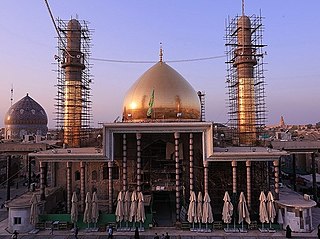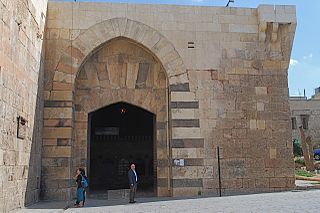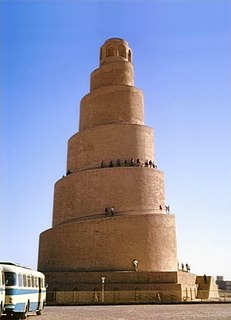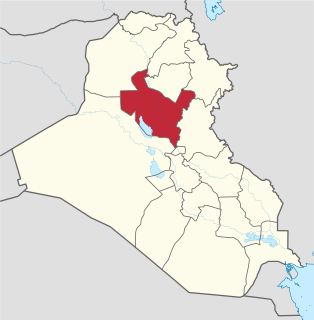
Abū Isḥāq Muḥammad ibn Hārūn al-Rashīd, better known by his regnal name al-Muʿtaṣim biʾllāh, was the eighth Abbasid caliph, ruling from 833 until his death in 842. A younger son of Caliph Harun al-Rashid, he rose to prominence through his formation of a private army composed predominantly of Turkish slave-soldiers (ghilmān). This proved useful to his half-brother, Caliph al-Ma'mun, who employed al-Mu'tasim and his Turkish guard to counterbalance other powerful interest groups in the state, as well as employing them in campaigns against rebels and the Byzantine Empire. When al-Ma'mun died unexpectedly on campaign in August 833, al-Mu'tasim was thus well placed to succeed him, overriding the claims of al-Ma'mun's son al-Abbas.

Ghilman were slave-soldiers and/or mercenaries in the armies of the Abbasid, Ottoman, Safavid, Afsharid and Qajar empires.

Al-Mustaʿin was the Abbasid Caliph from 862 to 866, during the "Anarchy at Samarra". After the death of previous Caliph, al-Muntasir, the Turkish military leaders held a council to select his successor. They were not willing to have al-Mu'tazz or his brothers; so they elected Ahmad ibn Muhammad أحمد بن محمد, a grandson of al-Mu'tasim, who took the regnal name al-Mustaʿin bi-llah.

Al ‘Askarī Shrine, the ‘Askariyya Shrine or the Al-Askari Mosque is a Shi'ite Muslim mosque and mausoleum in the Iraqi city of Samarra 125 km (78 mi) from Baghdad. It is one of the most important Shia shrines in the world, built in 944. The dome was destroyed in a bombing by extremists in February 2006 and its two remaining minarets were destroyed in another bombing in June 2007, causing widespread anger among Shias. The remaining clock tower was also destroyed in July 2007. The dome and minarets were repaired and the mosque reopened in April 2009.

Bab Qinnasrin is one of the gates of the medieval Old City of Aleppo in northern Syria. In its present form, it dates to 1256.
Abu Ja'far Ashinas was a general of the Abbasid caliph al-Mu'tasim. One of the earliest and most prominent members of al-Mu'tasim's Turkish guard, he rose to become one of the leading figures of the empire under al-Mu'tasim, serving as a commander in the Amorium campaign, and playing a leading role in the purge of the old Abbasid elites that followed. He was also governor of Egypt from 834, as well as of the Levant and Upper Mesopotamia from 838 on, although in practice he appointed deputies to govern in his stead. Under al-Mu'tasim's successor al-Wathiq, his powers were extended further into a virtual viceroyalty over all western provinces of the caliphate.
Bugha al-Kabir or Bugha the Great, also known as Bugha al-Turki, was a 9th-century Turkic general who served the Abbasids.
Aytākh or Ītākh al-Khazarī was a leading commander in the Turkish army of the Abbasid caliph al-Mu'tasim.

The Sack of Amorium by the Abbasid Caliphate in mid-August 838 was one of the major events in the long history of the Arab–Byzantine Wars. The Abbasid campaign was led personally by the Caliph al-Mu'tasim, in retaliation to a virtually unopposed expedition launched by the Byzantine emperor Theophilos into the Caliphate's borderlands the previous year. Mu'tasim targeted Amorium, a Byzantine city in western Asia Minor, because it was the birthplace of the ruling Byzantine dynasty and, at the time, one of Byzantium's largest and most important cities. The caliph gathered an exceptionally large army, which he divided in two parts, which invaded from the northeast and the south. The northeastern army defeated the Byzantine forces under Theophilos at Anzen, allowing the Abbasids to penetrate deep into Byzantine-held Asia Minor and converge upon Ancyra, which they found abandoned. After sacking the city, they turned south to Amorium, where they arrived on 1 August. Faced with intrigues at Constantinople and the rebellion of the large Khurramite contingent of his army, Theophilos was unable to aid the city.
The Maghariba were a regiment in the regular army of the Abbasid Caliphate. The unit was formed in the early ninth century A.D. and consisted of soldiers who were of North African origin. During their history, the Maghariba participated in several military campaigns and played a significant role in the politics of the central government.
ʿUjayf ibn ʿAnbasa was one of the senior-most military leaders of the Abbasid Caliphate under the caliphs al-Ma'mun and al-Mu'tasim.
The Faraghina were a regiment in the regular army of the Abbasid Caliphate which was active during the ninth century A.D. Consisting of troops who originated from the region of Farghana in Transoxiana, the Faraghina participated in several military campaigns and played a significant role in the politics of the central government, especially during the Anarchy at Samarra.
Mankjur or Minkajur al-Farghani or al-Ushrusani was a 9th-century Turkic or Iranian military officer in the service of the Abbasid Caliphate. He was a cousin of the prominent Abbasid general Khaydhar ibn Kawus al-Afshin, thus belonging to the ruling family of Ushrusana. Mankjur accompanied al-Afshin in his campaign against the Khurramite Babak Khorramdin, and was later appointed as governor of Adharbayjan by him in 837. However, in 839, Mankjur, after refusing to give the caliph al-Mu'tasim some of Babak's booty, revolted against him. Al-Mu'tasim responded by sending against him Bugha al-Kabir, who managed to suppress his revolt and imprison him in Samarra. The affair of Mankjur raised suspicions about the loyalty of the al-Afshin, who was accused of encouraging the revolt, and contributed to the general's own downfall in the following year.
Wasif al-Turki was a Turkish general in the service of the Abbasid Caliphate. He played a central role in the events that followed the assassination of al-Mutawakkil in 861, known as the Anarchy at Samarra. During this period he and his ally Bugha al-Sharabi were often in effective control of affairs in the capital, and were responsible for the downfall of several caliphs and rival officials. After Wasif was killed in 867, his position was inherited by his son Salih.

Samarra is a city in central Iraq, which served as the capital of the Abbasid Caliphate from 836 to 892. Founded by the caliph al-Mu'tasim, Samarra was briefly a major metropolis that stretched dozens of kilometers along the east bank of the Tigris, but was largely abandoned in the latter half of the 9th century, especially following the return of the caliphs to Baghdad.
Abu al-Husayn Ishaq ibn Ibrahim was a ninth-century official in the service of the Abbasid Caliphate. A member of the Mus'abid family, he was related to the Tahirid governors of Khurasan, and was himself a prominent enforcer of caliphal policy during the reigns of al-Ma'mun, al-Mu'tasim, al-Wathiq, and al-Mutawakkil. In 822 he was appointed as chief of security (shurtah) of Baghdad, and over the next three decades he oversaw many of the major developments in that city, including the implementation of the mihnah or inquisition, the removal of the Abbasid central government to Samarra, and the suppression of the attempted rebellion of Ahmad ibn Nasr al-Khuza'i. After his death, the shurtah of Baghdad briefly remained in the hands of his sons, before being transferred to the Tahirid Muhammad ibn 'Abdallah ibn Tahir in 851.
Al-Fatḥ ibn Khāqān was an Abbasid official and one of the most prominent figures of the court of the Caliph al-Mutawakkil. The son of a Turkic general of Caliph al-Mu'tasim, al-Fath was raised at the caliphal palace alongside the future al-Mutawakkil and adopted by al-Mu'tasim at age seven. With the accession of al-Mutawakkil, he occupied a series of official posts, including governor of Egypt and the Syrian provinces, but his power stemmed mainly from his close relationship to al-Mutawakkil, whose main adviser and confidante he was. A well-educated man and ardent bibliophile, al-Fath was himself a writer and a patron of writers, and assembled a large library at his palace at Samarra. He was assassinated by the Turkic guard alongside al-Mutawakkil.
The shākiriyya were a regular cavalry regiment of the Abbasid Caliphate in the "Samarra period" in the 9th century. Probably of Khurasani and Iranian origin, they were rivals of the Turkish guard, and played a major role in the court conflicts that marked the decade of the "Anarchy at Samarra" in the 860s.










